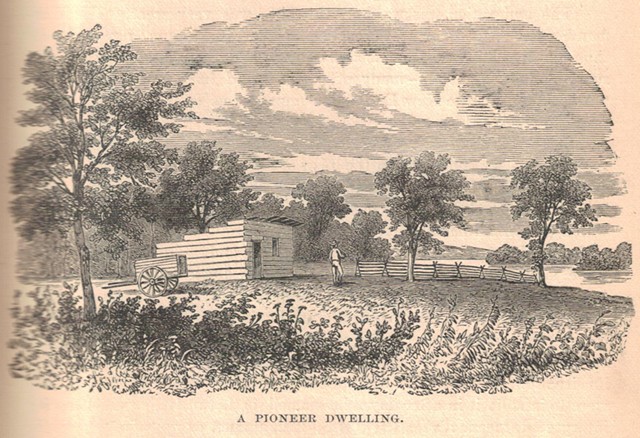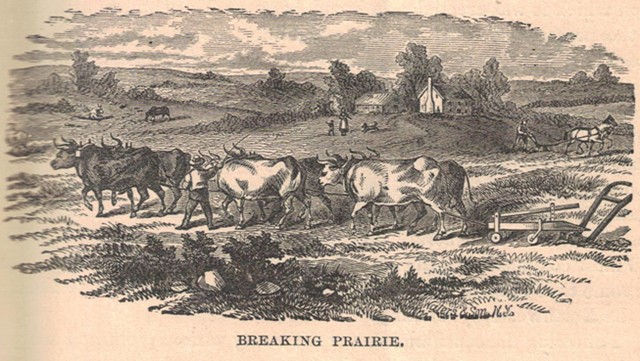. . . been made by the Indians owing to the great fertility of the soil. Mr. Stiltes with his colony came to this place on the 18th of November, 1788, with twenty-six persons, and, building a block-house, prepared to remain through the Winter. They named the settlement Columbia. Here they were kindly treated by the Indians, but suffered greatly from the flood of 1789.
On the 4th of March 1789, the Constitution of the United States went into operation, and on April 30, George Washington was inaugurated President of the American people, and during the next Summer, an Indian war was commenced by the tribes north of the Ohio. The President at first used pacific means, but these failing, he sent General Harmer against the hostile tribes. He destroyed several villages, but was defeated in two battles, near the present City of Fort Wayne, Indiana. From this time till the close of 1795, the principal events were the wars with the various Indian tribes. In 1796, General St. Clair was appointed in command, and marched against the Indians; but while he was encamped on a stream, the St. Mary, a branch of the Maumee, he was attacked and defeated with the loss of six hundred men.
General Wayne was now sent against the savages. In August, 1794, he met them near the rapids of the Maumee, and gained a complete victory. This success, followed by vigorous measures, compelled the Indians to sue for peace, and on the 30th of July, the following year, the treaty of Greenville was signed by the principal chiefs, by which a large tract of country was ceded to the United States.
Before proceeding in our narrative, we will pause to notice Fort Washington, erected in the early part of this war on the site of Cincinnati. Nearly all of the great cities of the Northwest, and indeed of the . . .
Pg 64
. . . whole country, have had their nuclei in those rude pioneer structures, known as forts or stockades. Thus Forts Dearborn, Washington, Ponchartrain, mark the original sites of the now proud Cities of Chicago, Cincinnati and Detroit. So of most of the flourishing cities east and west of the Mississippi. Fort Washington, erected by Doughty in 1890, was a rude but highly interesting structure. It was composed of a number of strongly-built hewed log cabins. Those designed for soldiers’ barracks were a story and a half high, while those composing the officers quarters were more imposing and more conveniently arranged and furnished. The whole were so placed as to form a hollow square, enclosing about an acre of ground, with a block house at each of the four angles.
The logs for the construction of this fort were cut from the ground upon which it was erected. It stood between Third and Fourth Streets of the present city (Cincinnati) extending east of Eastern Row, now Broadway, which was then a narrow alley, and the eastern boundary of the town as it was originally laid out. On the bank of the river, immediately in front of the fort, was an appendage of the fort, called the Artificer’s Yard. It contained about two acres of ground, enclosed by small contiguous buildings, occupied by workshops and quarters of laborers. Within this enclosure there was a large two-story frame house, familiarly called the ”Yellow House,” built for the accommodation of the Quartermaster General. For many years this was the best finished and most commodious edifice in the Queen City. Fort Washington was for some time the headquarters of both the civil and military governments of the Northwestern Territory.
Following the consummation of the treaty various gigantic land speculations were entered into by different persons, who hoped to obtain from the Indians in Michigan and northern Indiana, large tracts of lands. These were generally discovered in time to prevent the outrageous schemes from being carried out, and from involving the settlers in war. On October 27, 1795, the treaty between the United States and Spain was signed, whereby the free navigation of the Mississippi was secured.
No sooner had the treaty of 1795 been ratified than settlements began to pour rapidly into the West. The great event of the year 1796 was the occupation of that part of the Northwest including Michigan, which was this year, under the provision of the treaty, evacuated by the British forces. The United States, owing to certain conditions, did not feel justified in addressing the authorities in Canada in relation to Detroit and other frontier posts. When at last the British authorities were called to give them up, they at once complied and General Wayne, who had done so much to preserve the frontier settlements, and who, before the year’s close, sickened and died near Erie, transferred his head- . . .
Pg 65
. . . quarters to the neighborhood of the lakes, where a county named after him was formed, which included the northwest of Ohio, all of Michigan, and the northeast of Indiana. During the same year settlements were formed at the present City of Chillicothe, along the Miami from Middletown to Piqua, while in the more distant West, settlers and speculators began to appear in great numbers. In September, the city of Cleveland was laid out, and during the Summer and Autumn, Samuel Jackson and Jonathan Sharpless erected the first manufactory of paper—the “Redstone Paper Mill”—in the West. St. Louis contained some seventy houses, and Detroit over three hundred, and along the river, contiguous to it, were more than three thousand inhabitants, mostly French Canadians, Indians and half-breeds, scarcely any Americans venturing yet into that part of the Northwest.
The election of representatives for the territory had taken place, and on the 4th of February, 1799, they convened at Losantiville—now known as Cincinnati, having been named so by Gov. St. Clair, and considered the capital of the Territory—to nominate persons from whom the members of the Legislature were to be chosen in accordance with a pervious ordinance. This nomination being made, the Assembly adjourned until the 16th of the following September. From those named the President selected as members of the council, Henry Vandenburg, of Vincennes, Robert Oliver, of Marietta, James Findlay and Jacob Burnett, of Cincinnati, and David Vance, of Vanceville. On the 16th of September the Territorial Legislature met, and on the 24th the two houses were duly organized, Henry Vandenburg being elected President of the Council.
The message of Gov. St. Clair was addressed to the Legislature September 20th, and on October 13th that body elected as a delegate to Congress Gen. Wm. Henry Harrison, who received eleven of the votes cast, being a majority of one over his opponent, Arthur St. Clair, son of Gen. St. Clair.
The whole number of acts passed at this session, and approved by the Governor, were thirty-seven—eleven others were passed, but received his veto. The most important of those passed related to the militia, to the administration, and to taxation. On the 19th of December this protracted session of the first Legislature in the West was closed, and on the 30th of December the President nominated Charles Willing Bryd to the office of Secretary of the Territory vice Wm. Henry Harrison, elected to Congress. The Senate confirmed his nomination the next day.






